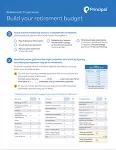You've spent your career saving for retirement. But once you retire, how do you switch to spending? Follow these tips to create a withdrawal strategy.

Making an efficient retirement withdrawal strategy maximizes the portion of your retirement savings that winds up in your pocket and minimizes how much goes to taxes.
You've spent your career saving for retirement. But once you retire, how do you switch to spending those funds?
A sturdy withdrawal strategy gives you the retirement income you need—while working in your favor when it comes to taxes and distribution requirements.
“Making an efficient retirement withdrawal strategy maximizes the portion of your retirement savings that winds up in your pocket and minimizes how much goes to taxes,” says Kevin Hansen, knowledge hub director for Principal®. “That’s money you could use to spoil your grandkids, go on vacation, or leave to your heirs.”
How much can I spend in retirement?
To determine how much retirement income you’ll likely need:
- Calculate your annual retirement spending. Look at your spending history and break down your annual estimate into a monthly figure.
- Calculate how much of that need is met by Social Security, pensions, annuities, and work income.
- To cover the remaining amount, categorize your savings into two buckets:
- Accounts built with after-tax dollars, such as bank accounts and investments that aren’t tax-deferred. Options such as a Roth IRA or Roth 401(k) also allow tax-free distribution in retirement.
- Tax-deferred accounts, such as traditional IRAs, 401(k)s, and 403(b)s.
- Accounts built with after-tax dollars, such as bank accounts and investments that aren’t tax-deferred. Options such as a Roth IRA or Roth 401(k) also allow tax-free distribution in retirement.

How do taxes and RMDs affect retirement withdrawals?
Think of required minimum distributions (RMDs) as the reliable paycheck funding your retirement budget.
Starting at age 72, you’ll generally withdraw an assigned amount from tax-deferred accounts or any account that requires a lifetime RMD, either in a lump sum or a series of withdrawals.
Any RMD that hasn’t been withdrawn for the year could be subject to a 50% tax penalty.
This is where donating to charity—aka a qualified charitable distribution (QCD)—can both satisfy the RMD and avoid taxation.
“When you withdraw money from an asset that’s more tax efficient and give money to charity from your IRA through a QCD, you can save a bit on taxes,” Hansen says.

4 min read
What are RMDs and when do you have to take them?
What are RMDs? They’re essential to your retirement planning, and important to get the details, such as how they’re calculated and when they should be taken, right.
Next, consider withdrawing from accounts that are taxable to you—regardless of whether you spend or reinvest those distributions. Examples include capital gains, dividends, and interest. (Keep in mind that these different types of distribution may be taxed at different rates.)
For most retirees, it’s generally best to avoid withdrawing more than the RMD from tax-deferred accounts because every dollar withdrawn is taxed as ordinary income.
However, if your overall income is lower than normal one year, or if you feel your future tax rate will go up, you might consider drawing from tax-deferred accounts—only until it would push you into the next marginal tax bracket.
What inheritance is best for my heirs?
Looking even further ahead, you may also consider what taxes your kids or beneficiaries may pay.
Known as a generational tax strategy, this involves drawing from tax-deferred accounts for heirs likely to be in a high tax bracket.
It may benefit them to inherit taxable assets because those assets enjoy a , meaning the capital gains tax on the assets are based on the value when inherited rather than the original purchase price. That can often result in a significant tax savings.
Example: Say you’re in a middle tax bracket and your heir is in a higher one (or likely to be in the future). If they inherit your 401(k), they’ll have to withdraw that money within 10 years and pay taxes at whatever bracket they’re in.
If instead you use that money and leave stocks, land, or other types of assets to your heirs, they may be able to sell those assets with little or no taxation due to the step-up in basis.
No single withdrawal strategy is right for everyone. But how you spend, plus the market conditions at the time, can have a big impact on how long your money lasts. Consult a financial professional or tax advisor before making any major decisions.
What's next?
 to review what amounts you’re working with. First time logging in? .


